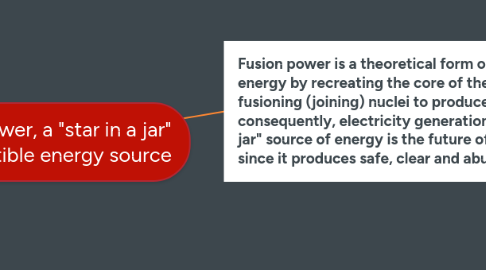
1. Fusion power is a theoretical form of generating energy by recreating the core of the Sun i.e. by fusioning (joining) nuclei to produce heat and, consequently, electricity generation. This "star in a jar" source of energy is the future of the energy sector since it produces safe, clear and abundant energy.
1.1. ....................................................FUSION IMAGE.............................................................................................
1.1.1. Advantages
1.1.1.1. Environment
1.1.1.1.1. It is CO2 neutral. It does not contribute to greenhouse effect, unlike the present main energy sources.
1.1.1.2. Safety
1.1.1.2.1. There is no risk of uncontrolled energy release as if the nuclear fusion takes place and the system collapse, the reaction would stop by itself. Moreover, it can not produce runaway chain reactions. Therefore, there is no chance of explosion.
1.1.1.3. Profit
1.1.1.3.1. It produces a considerable quantity of energy compared to the one provided in the beginning.
1.1.1.4. Radioactivity
1.1.1.4.1. It does not produce great quantities of high level radioactive waste compared to current nuclear plants.
1.1.1.5. Availability
1.1.1.5.1. The fuel in nuclear fusion (mainly deuterium found in seawater) is effectively unlimited since it is easy to access and available in a large scale.
1.1.1.6. Location
1.1.1.6.1. It does not depend on the weather so it could provide very high power-generation density without being in the best climate conditions.
1.1.2. Requirements
1.1.2.1. Worth
1.1.2.1.1. Energy released must be higher than the provided. If not, more energy would be more energy consumed than generated and this would not be worth it.
1.1.2.2. High temperature and pressure
1.1.2.2.1. It is needed a temperature of 100,000,000 °C and a pressure similarly insane to heat the atoms up to make plasma (state of matter composed of free electrons and nuclei that fuels fusion reactions) and, in this way, make possible the fusion between the two atoms, overcoming the repulsive barrier between the relatively large positive electrical charges (protons) of the nuclei (see the picture of fusion).
1.1.2.3. Material
1.1.2.3.1. It is needed a material vessel that could possibly contain the plasma required, the fusion reaction itself and the free fast neutron that could react with the nuclei of the metals in the containment vessel and produce cracks in it and harmful radiation.
1.1.3. Impact
1.1.3.1. Energy sector
1.1.3.1.1. Fusion releases 10,000,000 more times than energy from coal. This energy source is the future in the energy sector since, due to the availability of fuel, it could easily satisfy the energy needs associated to economic growth.
1.1.3.2. Renewable resources
1.1.3.2.1. Fusion plants requires less land surface area than large-scale renewable resources such as solar panels or wind turbines. That is why fusion might became an alternative to them.
1.1.3.3. Industry
1.1.3.3.1. It can come to reorganize the structure of the industry since it will be an unlimited source of energy for them.
1.1.4. Concerns
1.1.4.1. Even though it does not generate long-lived radioactive products, there are still problems in the short- medium-term radioactive waste due to the reaction of the free fast neutrons that can react. However, the long-term radioactive waste is considerably lower than the generated in the current nuclear power plants.
1.1.4.2. The release of tritium into the environment could have disastrous consequences. For example, in contact with water it can be incorporated to it and make the water slightly radioactive.
